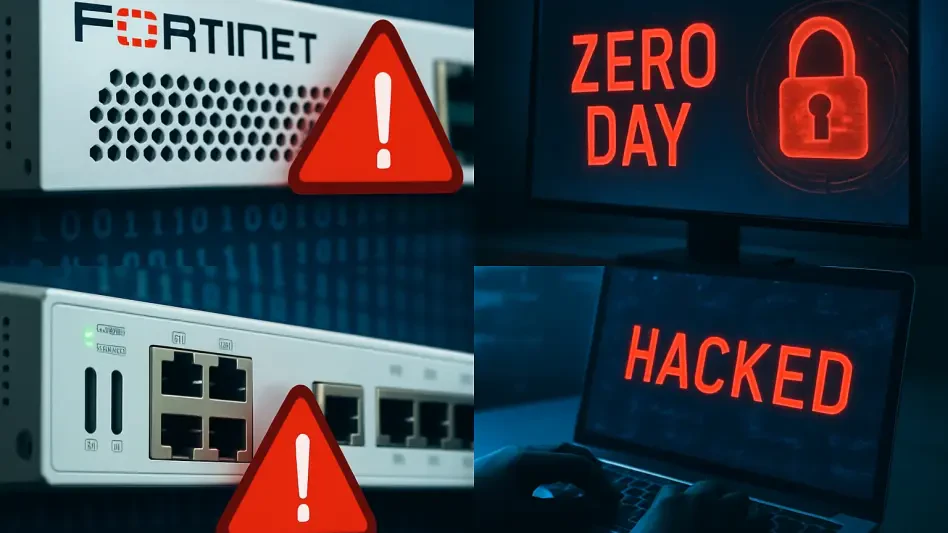In a digital landscape where cyber threats loom larger than ever, federal agencies are racing against time to shield their critical infrastructure from a pair of devastating zero-day vulnerabilities in Fortinet FortiWeb systems, which have already been exploited by malicious actors. This alarming situation has prompted an urgent mandate from the Cybersecurity and Infrastructure Security Agency (CISA), setting strict deadlines for remediation to prevent unauthorized access and system compromise, with the stakes for national security at an all-time high.
The significance of this story lies in the immediate danger posed by these vulnerabilities, which target web application firewalls—tools designed to protect against cyber intrusions. As attackers actively exploit these flaws, CISA’s swift action underscores a broader mission to safeguard federal systems from sophisticated threats. This isn’t just a technical glitch; it’s a wake-up call about the relentless pace of cyber warfare and the critical need for rapid response in an era of escalating digital risks.
Why Fortinet FortiWeb Flaws Are Alarming Federal Agencies
The discovery of two zero-day vulnerabilities in Fortinet FortiWeb systems has sent shockwaves through federal cybersecurity circles. These flaws, already under active exploitation, threaten the very infrastructure meant to defend against online attacks. CISA has issued a stark warning, emphasizing that the active nature of these threats demands immediate attention from federal civilian executive branch agencies.
What makes this situation particularly dire is the role FortiWeb plays as a web application firewall, a frontline defense for countless government systems. When such a protector becomes a point of vulnerability, the ripple effects can compromise sensitive data and critical operations. The urgency is palpable, as CISA’s mandates reflect a recognition that delays could lead to catastrophic breaches in national security frameworks.
This crisis also highlights a troubling reality: federal agencies, often prime targets for state-sponsored actors and cybercriminals, must contend with flaws that are exploited before patches are even available. The tight deadlines set by CISA—ranging from days to weeks—demonstrate the gravity of a situation where every moment counts in preventing widespread damage.
The Growing Menace of Zero-Day Exploits in Vital Systems
Zero-day vulnerabilities, by their very nature, represent a unique and insidious threat in the cybersecurity realm. These flaws, unknown to vendors or users until they are actively exploited, leave little room for proactive defense. In the case of Fortinet FortiWeb, the exploitation of such vulnerabilities in a tool meant to secure web applications reveals a chilling irony—defenses themselves becoming entry points for attackers.
The broader trend of zero-day exploits targeting critical systems is a mounting concern, especially for federal environments. Statistics paint a grim picture: according to a report by the Ponemon Institute, the average cost of a data breach in the public sector exceeds $2 million per incident. When these breaches stem from zero-days in essential tools like firewalls, the potential for cascading failures across interconnected systems amplifies the risk exponentially.
Federal agencies face an uphill battle as attackers grow more sophisticated, often leveraging zero-days to bypass traditional security measures. The active exploitation of FortiWeb flaws serves as a stark reminder that no system is immune, pushing the need for constant vigilance and rapid response mechanisms to the forefront of cybersecurity strategies.
Breaking Down the FortiWeb Zero-Days: Severity and Consequences
At the heart of this crisis are two critical vulnerabilities shaking the foundation of Fortinet FortiWeb systems. The first, identified as CVE-2025-58034, carries a high severity score of 7.2 on the CVSS scale. It allows authenticated attackers to execute unauthorized code through specially crafted HTTP requests or command-line interface commands, impacting versions ranging from 7.0.0 to 8.0.1, with patches now available in updated releases.
The second flaw, CVE-2025-64446, is even more alarming with a near-perfect CVSS score of 9.8. This critical path traversal vulnerability enables attackers to run administrative commands via HTTP or HTTPS requests, posing a severe risk of total system compromise. CISA has added both to its Known Exploited Vulnerabilities catalog, signaling real-world attacks and setting remediation deadlines of November 25 for the first flaw and November 21 for the second.
The potential impact of these vulnerabilities cannot be overstated. If left unaddressed, they could grant attackers unrestricted access to sensitive federal systems, leading to data theft, operational disruptions, or worse. The active exploitation already underway means that the window for mitigation is dangerously narrow, underscoring why CISA’s urgent mandates are not just recommendations but imperatives for survival.
Expert Perspectives: Collaboration Amidst Exploitation Challenges
Insights from the cybersecurity community shed light on the complexities of tackling the FortiWeb crisis. Jason McFadyen of Trend Micro’s Trend Research team, credited with reporting CVE-2025-58034, exemplifies the critical role of responsible disclosure in limiting damage. His efforts highlight how collaboration between researchers and vendors can accelerate the development of patches, even under intense pressure from ongoing attacks.
However, the reality of active exploitation at the time of disclosure paints a sobering picture. Attackers often outpace defensive measures, exploiting flaws before organizations can react. This dynamic, as noted by industry observers, reveals a persistent gap in cybersecurity readiness, where even the best collaborative efforts struggle to keep up with the speed and ingenuity of malicious actors.
CISA’s rapid response, framed under Binding Operational Directive 22-01, reflects a shared understanding among experts that protecting critical infrastructure requires more than just patches—it demands a cultural shift toward proactive threat hunting. This consensus drives home the point that while individual contributions matter, systemic action is the only way to counter such pervasive threats effectively.
Practical Measures to Meet CISA’s Tight Deadlines
For federal agencies and private entities using Fortinet FortiWeb, actionable steps are essential to mitigate these vulnerabilities before they spiral into full-blown crises. The first priority is identifying affected systems by auditing deployments to confirm if they fall within the vulnerable version ranges, such as 7.0.0 to 8.0.1 for CVE-2025-58034. This initial assessment sets the stage for targeted remediation.
Next, applying patches without delay is non-negotiable—Fortinet has released updates like version 8.0.2 and 7.6.6 to address these flaws. Alongside patching, deploying monitoring tools to detect suspicious activity, such as unusual HTTP/HTTPS requests or command-line anomalies, adds a crucial layer of defense. For federal agencies, adhering to CISA’s deadlines of November 25 for one flaw and November 21 for the other is not just compliance but a safeguard against active threats.
Beyond immediate fixes, organizations must consider long-term strategies, such as regular vulnerability assessments and enhanced training for IT staff to recognize exploitation attempts early. These measures, aligned with CISA’s guidance, provide a robust framework to reduce risk, ensuring that systems remain resilient even as new threats emerge on the horizon.
Reflecting on a Critical Moment in Cybersecurity
Looking back, the urgency surrounding the Fortinet FortiWeb zero-day vulnerabilities served as a defining challenge for federal cybersecurity efforts. The active exploitation of these flaws exposed vulnerabilities in tools meant to protect, reminding all stakeholders of the relentless nature of digital threats. CISA’s decisive mandates under tight deadlines became a pivotal response, galvanizing action across agencies.
As the dust settled, the path forward demanded more than just patches—it required a commitment to proactive measures. Strengthening collaboration between vendors, researchers, and government bodies emerged as a key takeaway, ensuring faster identification and mitigation of future zero-days. Investing in advanced threat detection systems also stood out as a necessary step to stay ahead of attackers.
Ultimately, this episode underscored the importance of agility in cybersecurity governance. Federal agencies and private organizations alike were prompted to prioritize regular system audits and rapid response protocols, building a more resilient defense against an ever-evolving threat landscape. This reflection paved the way for sustained vigilance, ensuring that lessons learned translated into lasting protections.








